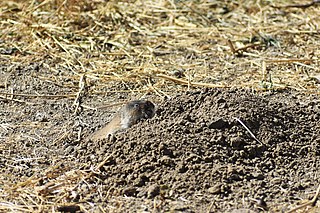
Voles are small rodents that are relatives of lemmings and hamsters, but with a stouter body; a longer, hairy tail; a slightly rounder head; smaller eyes and ears; and differently formed molars. They are sometimes known as meadow mice or field mice in North America.

The Arvicolinae are a subfamily of rodents that includes the voles, lemmings, and muskrats. They are most closely related to the other subfamilies in the Cricetidae. Some authorities place the subfamily Arvicolinae in the family Muridae along with all other members of the superfamily Muroidea. Some refer to the subfamily as the Microtinae or rank the taxon as a full family, the Arvicolidae.

The Balkan snow vole, also known as Martino's snow vole, is the only living member of the genus Dinaromys. The genus name means "Dinaric mouse", referring to the Dinaric Alps, as the species is endemic to the western Balkans of southeast Europe. Eight subspecies of this vole have been recognized, although in 2022 this number was reduced to two subspecies. The Balkan snow vole is a living fossil, the only living species in the tribe Pliomyini, and might arguably better be placed in Pliomys, a genus established for its fossil relatives even before the Balkan snow vole was scientifically described. It was described by husband and wife mammalogists Vladimir Emmanuilovich Martino and Evgeniya Veniaminovna Martino. Others have argued that Pliomys should be treated as entirely separate from Dinaromys, with Dinaromys and P. lenki estimated to have genetically diverged around 4 million years ago based on ancient DNA sequences. The earliest representatives of Dinaromys like Dinaromys allegranzii date to the Early Pleistocene, with Dinaromys also inhabiting the Italian Peninsula until the end of the Late Pleistocene, when it contracted to its current distribution.
The Alai mole vole is a species of rodent in the family Cricetidae. It is known only from Kyrgyzstan, where it has been found in temperate grassland in the Alai Mountains. Little else is known about the vole.

Ellobius is a genus of rodents in the family Cricetidae. It contains two of the handful of examples of mammal species that have lost the Y chromosome.
The southern mole vole is a species of rodent in the family Cricetidae. It is found in Afghanistan, Iran, Pakistan, and Turkmenistan.

The Transcaucasian mole vole is a species of rodent in the family Cricetidae.

The northern mole vole is a species of rodent in the family Cricetidae. It is distributed over large parts of Eastern Europe and Asia.

The Zaisan mole vole, or eastern mole vole, is a species of rodent in the family Cricetidae. It is found in central Asia.

Eothenomys is a genus of rodent in the family Cricetidae. It contains the following species:

Père David's vole is a species of rodent in the family Cricetidae. It is found in China, Myanmar, Taiwan, India, Vietnam, and Thailand. This species is a member of the melanogaster group, one of the two main groups of Eothenomys voles. Its dorsal pelage is dark brown, often nearly black, and the ventral pelage is gray, sometimes brown. The tail is shorter than the body. This species is found in pine/rhododendron forests.
The Yulungshan vole, Yulong Chinese vole, Yulongxuen Chinese vole, or Yulongxuen red-backed vole is a species of rodent in the family Cricetidae, endemic to Jade Dragon Snow Mountain in the Sichuan–Yunnan border region of China.
Gerbe's vole or the Pyrenean pine vole is a species of rodent in the family Cricetidae found in the in France, Andorra, and Spain.

The social vole is a species of rodent in the family Cricetidae. It is found in China, Iran, Kazakhstan, Syria, Turkey, Tajikistan, Kyrgyzstan, Russia, Georgia, Azerbaijan, Armenia and Ukraine. It may also be found in northern Iraq, where either this species and/or the closely-related Doğramaci's vole is found.
The Lake Baikal mountain vole or Olkhon mountain vole is a species of rodent in the family Cricetidae. It is found principally on the Olkhon and Ogoi islands on Lake Baikal, in southern Siberia. It is also found in a small part of the bordering mainland Russia, on the Baikal coast of the Irkutsk Oblast. It was originally described as a subspecies of the silver mountain vole. Since then, it has been synonymized with A. roylei in 1978, A. tuvinicus, and A. macrotis before reinstating it as a species. It is likely a sister species to A. tuvinicus.
Doğramaci's vole is a species of rodent in the family Cricetidae. It is found in Turkey, Syria, Jordan, Iran, and probably Iraq and Lebanon. It was previously believed to be native only to central Turkey. It is similar to the social vole, although different in terms of cranial proportions and karyotype.

Bramus is a genus of fossorial rodents. It formerly contained only the extinct North African species Bramus barbarus. Both species in Bramus were moved to this genus from Ellobius. They differ from Ellobius in being larger, having a distinct sagital crest, and other features of the teeth and skull. They also occur allopatrically from Ellobius. They are sexually dimorphic, with females being larger than males. The genus comprises two species:








